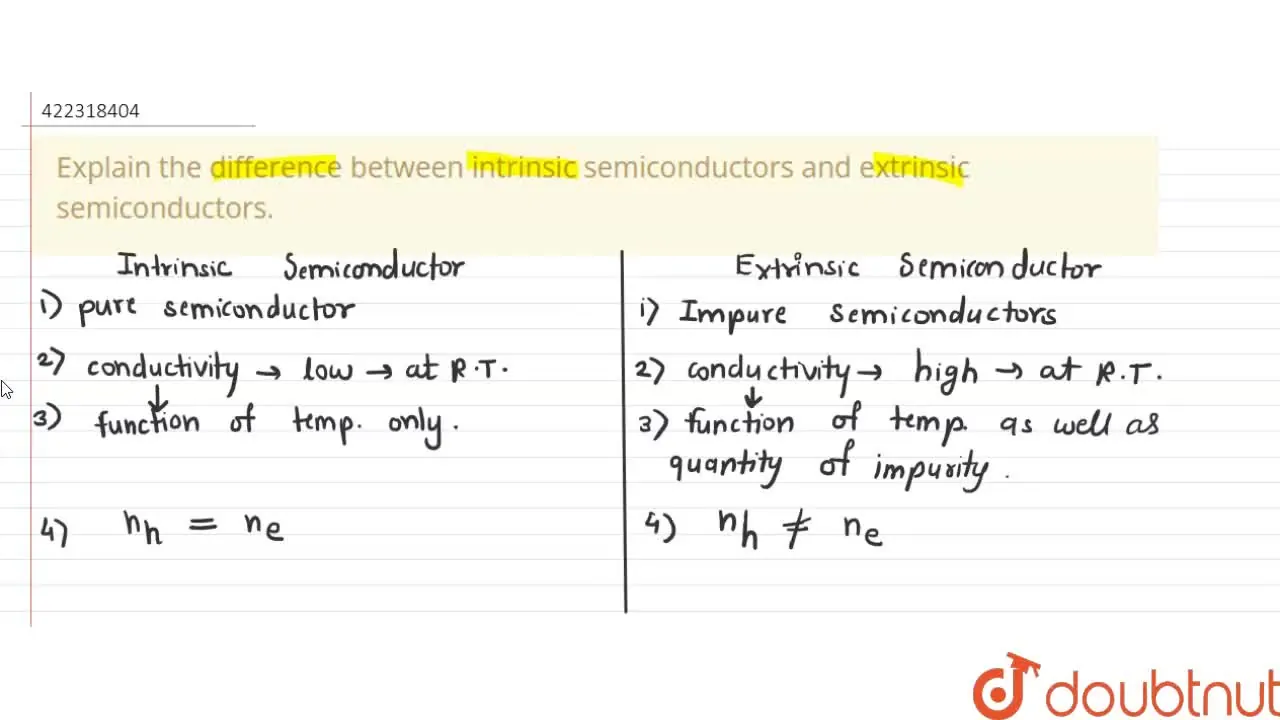Explain the difference between intrinsic semiconductors and extrinsic semiconductors.
Video Solution
Text Solution
Intrinsic semiconductor. An intrinsic semiconductor is a pure semiconductor . Outer shell of such semiconductors are complete at low temperatures and they behave as insulators. At room temperature, due to thermal agitation, a few electrons are freed creating some holes. These holes are filled by electrons from some covalent bonds thereby creating more holes. Thus at room temepratures a pure semiconductors will have a feq electrons and holes which are called intrinsic carriers. It should be noted that these electrons and holes are not current in themselves but they act as the negative and positive carriers of current respectively.
As the temperature rises, a large number of electrons cross over the forbidden gap and jump from valence band to conduction band. Hence conductivity of a semiconductor increases with rise of temperature.
Extrinsix semiconductor. A pure semiconductor, at room temperature , has a few electrons and holes and so the conductivity offered by the pure semiconductor cannot be made of any practical use. By adding suitable impurities (pentavalent impurity or trivalent impurity), the conductivity of the semiconductor can be remarkably improved. Such a crystal, in which doping is done, is called extrinsic semiconductor.
Just we have pure (intrinsic) n-type and p-type semiconductors, similarly we can obtain p-type (extrinsic) semiconductor or n-type (extrinsic) semiconductor.
|
Updated on:21/07/2023
Related Playlists
- BOOK - MBD -HARYANA BOARDCHAPTER - SOLIDS AND SEMICONDUCTOR DEVICESEXERCISE - Long answer type questions6videos
SOLIDS AND SEMICONDUCTOR DEVICES
- BOOK - MBD -HARYANA BOARDCHAPTER - SOLIDS AND SEMICONDUCTOR DEVICESEXERCISE - Objective type questions21videos
SOLIDS AND SEMICONDUCTOR DEVICES
- BOOK - MBD -HARYANA BOARDCHAPTER - SOLIDS AND SEMICONDUCTOR DEVICESEXERCISE - Objective type questions21videos
SOLIDS AND SEMICONDUCTOR DEVICES
- BOOK - MBD -HARYANA BOARDCHAPTER - PRINCIPLES OF COMMUNICATIONEXERCISE - Objective Type Questions19videos
PRINCIPLES OF COMMUNICATION
Similar Questions
In extrinsic semiconductors
View SolutionIn extrinsic semiconductors-
View SolutionIn a intrinsic semiconductor
View SolutionIntrinsic and extrinsic semiconductors
View SolutionIntrinsic and extrinsic semiconductors .
View SolutionIn an intrinsic semiconductor
View SolutionIntrinsic and Extrinsic Semiconductor
View SolutionWhat is an extrinsic semiconductor ?
View SolutionIn intrinsic semiconductor conductivity is
View SolutionDistinguish between 'intrinsic' and 'extrinsic semiconductors.
View Solution


